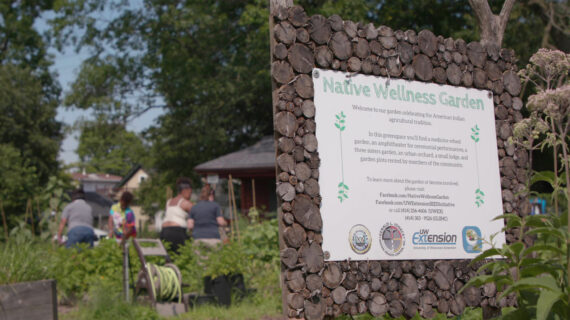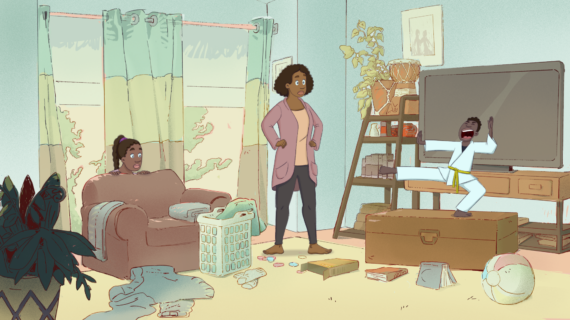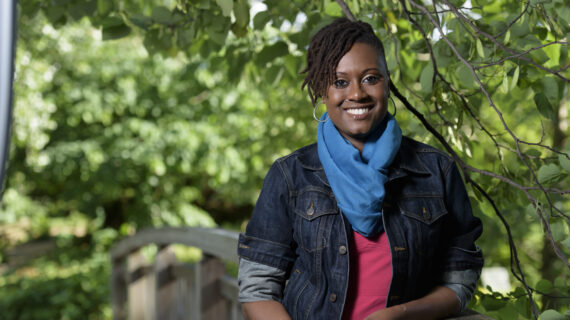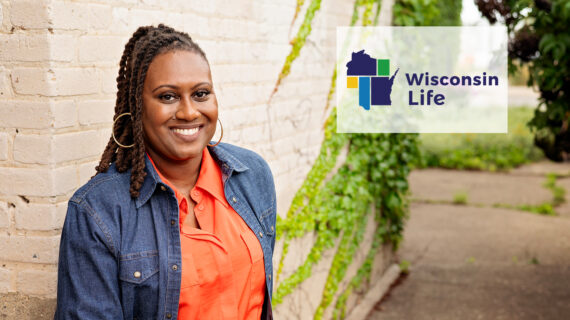Frederica Freyberg:
I’m Frederica Freyberg. Tonight on “Here & Now” we begin our series of state budget reporting with a story about funds directed to non-English speaking students and an inside look at the new Marquette Law School poll. It’s “Here & Now” for April 12.
Announcer:
Funding for “Here & Now” is provided in part by Friends of Wisconsin Public Television.
Frederica Freyberg:
A first look tonight at the state budget specifically for English learners in K-12 schools. Marisa Wojcik takes us to Green Bay and Abbotsford for the story.
Translator for Gilda Bay Agredar:
[speaking Spanish] Let’s say being here in the United States it’s very difficult.
Marisa Wojcik:
Imagine being surrounded by a language you don’t understand.
Translator for Gilda Bay Agredar:
There’s people that they push us aside only because we don’t know English.
Marisa Wojcik:
Now imagine trying to learn in a language you don’t understand.
Translator for Gilda Bay Agredar:
I try to look for support in others, but because I don’t know English, I can’t look for that support.
Marisa Wojcik:
Now imagine you are a school district providing this programming to hundreds even thousands of students with little or no aid from the state. This is the reality for school districts in Wisconsin.
Julie Seefeldt:
Green Bay is a district of about 21,000 students. 4,500 of those students are English learners. So it’s about 23% of our population.
Marisa Wojcik:
State and federal mandates require school districts to provide services to accommodate English language learners. In Wisconsin, the primary source of funding comes from bilingual bicultural aid.
Julie Seefeldt:
We have an approved bilingual bicultural program with the state of Wisconsin. We do get reimbursed for the cost of educating English learners. It’s a little below 8%.
Marisa Wojcik:
A national non-profit focusing on educational policy said of the states that provide this funding, Wisconsin is at the bottom of the pack.
Zahava Stadler:
This appropriation, if every kid were getting it, which is not quite true, would work out to about $200 a kid. Which frankly by national standards is pitiful.
Marisa Wojcik:
She attributes this to the amount of funding and how the funds are distributed.
Anne Chapman:
Wisconsin does provide funding for bilingual bicultural aid. It’s a special program that’s sort of added on top of the regular, you know, funding formula. It’s called categorical aid. This program only benefits school districts with certain concentrations of bilingual students.
Marisa Wojcik:
For a district like Green Bay with the third highest ELL student population in the state, they do receive bilingual bicultural aid for their students that have high numbers. The most common being Spanish speakers, Hmong and Somali students.
Julie Seefeldt:
For example we have some students who speak Swahili in this district but we have less than 10. And so we do not get reimbursement for the teachers who work with those Swahili-speaking students.
Anne Chapman:
School districts that receive no aid at all have to pull all the resources that they need to serve those students from their regular budget.
Marisa Wojcik:
And the need is growing.
Anne Chapman:
The funding levels are very low for the needs and all the districts that serve these students are struggling.
Julie Seefeldt:
English learners are the fastest growing population out there. Wisconsin has seen continued growth the past four to five years. This population has specific needs, and the current funding is just not meeting those needs.
Marisa Wojcik:
But it’s not just large districts like Green Bay navigating how to provide support to English language learners. Abbotsford, a small rural district, supports one third of their student population with bilingual, bicultural programming.
Georgia Kraus:
The program has just continued to grow and that brings in a whole new set of challenges.
Marisa Wojcik:
The population of Spanish speakers in Abbotsford has been steadily growing, filling jobs at a local meat industry in town.
Cheryl Baker:
The specific population that’s being drawn to these areas — they are being drawn because they can find work without competing. Right now, in Clark County alone, we cannot create enough workers for all the positions that are open.
Marisa Wojcik:
Some even end up working for the very school district that educated them. It can take years to be classified as English proficient. While learning English, they also need to keep up with their regular academic content. To compound the strain on a small district. Abbotsford has to meet other student needs.
Amber Kraus:
We’ve got English learners who are academically gifted and we’ve got English learners who have been out of school for a few years and helping them catch up academically.
Marisa Wojcik:
The district purchases materials that are both in English and Spanish.
Georgia Kraus:
The students actually sometimes will have two books on their desk: an English copy and a Spanish copy and then they bridge themselves.
Marisa Wojcik:
They provide bilingual guidance counselors and teachers aids and just recently, they started a dual language emersion program. Half the day all the students learn in Spanish and the other half all students learn in English.
Amber Kraus:
It’s not viewed as I’m different from you, no. It’s viewed as we’re learning this together.
Marisa Wojcik:
And these students need support beyond academics.
Translator for Laura Gutierrez Velazquez:
They don’t speak your language. That can affect you tremendously in a psychological way. In the sense that you have no friends, that nobody talks to you, and that can make you have bad thoughts like committing suicide. So you need a lot of support.
Marisa Wojcik:
Abbotsford has had no choice but to find creative solutions to an ever growing need in the district.
Anne Chapman:
This is a statewide issue because of the way we fund it in Wisconsin with this reimbursement method way below 100%. This is effecting overall school budgets all over the state. This is pulling — this is what some might call an unfunded mandate ’cause these school districts are required to identify, monitor and serve these kids.
Marisa Wojcik:
Districts across the state are already struggling to find good teachers applying for open positions. For Abbotsford, it’s further complicated by their location.
Cheryl Baker:
Rural schools are not in the same competition zone as the bigger cities because that’s what’s drawing our youth today.
Marisa Wojcik:
And their need for bilingual teachers.
Georgia Kraus:
We have also had to reach out and hire someone from another country to come in and teach for us.
Sheila Briggs:
If they’re not getting additional funding, districts have the authority to look at their entire budget and determine what to fund and how to support all of their students in the best way possible.
Marisa Wojcik:
In years past DPI has requested additional funding for bilingual bicultural programming and it hasn’t made the cut.
Sheila Briggs:
We are severely underfunded in supporting the language learners that we have in the state.
Marisa Wojcik:
In his first state budget proposal, Governor Tony Evers has proposed an additional $44 million for English language learners.
Georgia Kraus:
I think it’s always a concern. Not knowing the bilingual funding and how much that might be. It could evaporate tomorrow.
Marisa Wojcik:
Markers for academic achievement show Wisconsin English learners are way behind. Only 17% of third grade ELs are proficient in reading. And only 4% of eight grader are proficient in math.
Sheila Briggs:
All students should be supported to be able to achieve on an individual level and not have their achievement be predictive based on any group that they belong to.
Marisa Wojcik:
Experts say that without proper funding for these programs, English learners are going to continue to fall behind. But these students still see learning English as an opportunity.
Translator for Gilda Bay Agredar:
[speaking Spanish] I am from Guatemala. They discriminate against the people that don’t have resources or the possibilities to study.
Translator for Karla De a Cruz Moreno:
[speaking Spanish] You come here, get a job, you get money and you get a better life. Different from the one in your country.
Marisa Wojcik:
Reporting from Abbotsford and Green Bay, I’m Marisa Wojcik.
Frederica Freyberg:
Governor Evers’ proposed budget for K-12 education calls for big increases in public school funding. It would hike overall funding by nearly $1.4 billion over two years, including a more than $600 million increase for special education. $64 million more for mental health and school safety, that $44 million for bilingual services and $38 million more over two years for rural and urban districts. The executive budget proposal would also ensure all districts get a minimum level of state aid set at $3,000 per pupil. And it would cap the number of students who attend private school on state vouchers at current levels. In tonight’s closer look, we check in with school finance expert Julie Underwood, UW-Madison professor of education and law. Thanks for being here.
Julie Underwood:
Thank you for having me.
Frederica Freyberg:
My first question is how closely does this proposed budget on the part of Governor Evers hew to the recommendation of the bipartisan blue ribbon commission on school funding?
Julie Underwood:
That’s a great question because this budget and the blue ribbon commission was really giving me hope for bipartisan support of a good budget. As a matter of fact, we’ve put together a Venn diagram showing how the two of these actually intersect. How the governor’s budget and blue ribbon commission recommendations are similar. They’re incredibly similar. Their support for special education increases, their support for bilingual education increases. Their support for general overall increases for school funding. And also there is support for increases in terms of the spending limits or the school levies.
Frederica Freyberg:
Still what is your expectation that this kind of major funding increases for public K-12 school passes the budget process? Because right now Republican leaders are pushing back on this
Julie Underwood:
I know that at the very first Joint Finance Committee hearing here in Madison, that Senator Nygren actually called this budget proposal irresponsible. I don’t think it’s irresponsible at all. As you were just giving the numbers, this is in a context of a $1.6 billion budget cut in 2010. Today, our spending for public schools actually is less than our spending was in public schools in 2011. And we had a $1.6 billion budget cut in 2010. This wouldn’t move us past that. We’re just looking to restore the budget that was cut. I don’t think it’s an irresponsible budget. I think it’s irresponsible to cut school funding so significantly and to let it languish year after year.
Frederica Freyberg:
Specific to the English learners that Marisa reported on, what has it done to districts who’ve had to pull out of their general budget to make up for these unfunded or mostly unfunded mandates around services for these English learner students?
Julie Underwood:
Well that’s true for two categories of students. English learners and actually for students who have special needs as well, special education students. So if we start with English language learners, we are the last in the nation in terms of state support for bilingual education or English language learner support. We had a national expert who came to talk to the blue ribbon commission and categorized us at pitiful in terms of the support that we provide for bilingual education. That’s not good for learners. That’s not good for students. That’s not good for communities. But it’s also not good for schools and other learners as well because like special education, bilingual services are mandated, federally mandated services. That means we provide services to a certain level. In public schools, public schools provide services to a certain level. If there are costs that are greater than what they receive from the state and the federal government, those come straight out of the general education budget. When you add money to fill that gap, it releases money for services for all students.
Frederica Freyberg:
In your mind what is the most important prong of Governor Evers’ proposed K-12 budget?
Julie Underwood:
It’s hard to pull apart because you know, you pull one thread and these are all connected together. These are all about children. Children have different facets. They may be low income. They may be in a rural area. They may have special needs. Those are faucets of a child. Honestly, I believe that we have great hope to have the special education state money increased. We’re currently at a reimbursement rate for special education services at less than 25%. That’s gone down every year over the last 10 years when that pool of money was frozen. Right now, in the state of Wisconsin school districts pull about, cumulatively, about a billion dollars out of their regular education budget to fill their special education needs or to fulfill their special education needs. So that’s a billion dollar cut for other kind of services. We have bipartisan support for this one. Plus the Marquette poll just this week indicated we have a lot of political support from the general public for increasing special education reimbursement.
Frederica Freyberg:
And yet, as to that push back by some of the Republican leaders and budget writers, do you think this is at all a case on the part of the Evers Administration of asking for the moon and hoping to negotiate something that at least takes the edge off?
Julie Underwood:
No. No. This is a responsible look at what our children need, what our communities need. It isn’t asking for the moon. It’s not asking for twice what you need and then being willing to settle for much less. We transfer a billion dollars. Those services are cut out of other budgets. They’re federally mandated. Something we absolutely need. And in the state of Wisconsin, we’re among the last in terms of state support for special education. I think that’s irresponsible. I think that’s sad. We’ve had a history in the state of Wisconsin of being a leader for special education and for early childhood. Right now, we’re ranking among the last in the nation in those areas.
Frederica Freyberg:
We need to leave it there, Julie Underwood. Thank you.
Julie Underwood:
Thank you very much for having me.
Frederica Freyberg:
Now to state politics and policy as seen in the results of the latest Marquette Law School poll. But first, speaking of results, any possibility of a recount in the State Supreme Court race was put to rest this week. Lisa Neubauer who lost to Brian Hagedorn by about 6,000 votes conceded the race on Wednesday.
Now to the Marquette poll and the poll’s director, Charles Franklin. Thanks for being here.
Charles Franklin:
Thank you. Good to be here.
Frederica Freyberg:
Jumping right in with the lay of the land of public perception on the national level, Donald Trump. Your polling shows 46% approve of Donald Trump, while 52% disapprove in Wisconsin. Pretty consistently upside down in this state considering he won it.
Charles Franklin:
That’s right. He has been under water more disapproval than approval in all of our polling. This was a two point rise in his approval rating from January, 44, now 46. But remember in January, we were at the end of the government shutdown which had hurt his approval ratings nationally. I think there’s very little change here. But perhaps a slight bump up.
Frederica Freyberg:
The Mueller Report helps him, you think?
Charles Franklin:
It seems to in some ways. If you look at what people think of the Mueller Report that we know of at this point, not having seen the whole thing. People accept that Russia interfered with the election. 60% think that. A majority, over 50%, accept the conclusion that Trump did not interfere. But it’s dead even divided 45/45 on whether Trump tried to interfere with the investigation. So there’s been some movement that seems to be in the direction of the conclusions of the report but it doesn’t settle all dispute.
Frederica Freyberg:
Since we haven’t seen it. Looking ahead to 2020, the top three favorite opposing candidate on part of Dems polled are Bernie Sanders, Joe Biden and Elizabeth Warren. Now Bernie Sanders did win Wisconsin primary voters in 2016. So he’s got staying power here?
Charles Franklin:
It seems like it at least this early in the race. That’s also a nine point increase in his support since January. Biden has dropped off three points since January. Elizabeth Warren, in third place, is up a couple of points. Everybody else at 11 or below. We asked about 12 candidates in total. So most of them are down in single digits. But also more than half of the public haven’t heard enough to have an opinion about many of these candidate. That’ll resolve itself over the rest of the spring and the summer.
Frederica Freyberg:
On state issues, legalizing marijuana both recreation but especially medical, proves to have super strong support. Is this one of those issues that has changed quickly over time?
Charles Franklin:
It has changed, as recent as five or six years ago. Support for legalization in general was down in the low 40s, maybe the high 30s. It’s been moving up steadily and now at 59%, really quite a substantial majority. But medical marijuana at 83% is just enormous. That’s one that Democrats, Republicans and independents alike are all quite willing to legalize. It’s where I think public opinion has moved ahead of elected officials who are still reluctant to go there but public opinion is already there.
Frederica Freyberg:
On Medicaid expansion in Wisconsin, 70% support it. Does that number surprise you?
Charles Franklin:
We’ve asked it several times since the Affordable Care Act was passed and it’s had support above 50%, and often in the 60s. 70 is a little high. But unlike marijuana measure, this is one where partisan differences are stronger. Republicans are still rooted in their opposition to Obamacare and therefore a majority of Republicans would not take the money, whereas a majority of independents and Democrats would. And it’s different on the marijuana case.
Frederica Freyberg:
And yet the 70% for the expansion is an overall survey of all respondents, not partisan?
Charles Franklin:
That’s exactly right. That’s everybody.
Frederica Freyberg:
On hiking the gas tax as Governor Evers is proposing, that is not a popular idea according to your polling?
Charles Franklin:
And it never has been. We’ve asked about it multiple times over the last six years. People are complaining about the roads and they say it’s an important issue but when faced with paying for it through the gas tax, we’ve never had a poll where more people would say yes, I would pay for that to fix the roads, to work on the roads. That’s in contrast to public school funding where people moved from preferring lower property taxes to now preferring more school spending. But on the gas tax and roads, that movement has not taken place.
Frederica Freyberg:
Hence why this is such a vexing budget issue and has been for years in the state of Wisconsin.
Charles Franklin:
And it explains why we’ve just borrowed our way out of it for over eight years simple because there’s no easy solution that everybody’s lined up behind.
Frederica Freyberg:
Now with 52% of respondents saying Wisconsin is headed in the right track. Is this a good number for Tony Evers?
Charles Franklin:
It’s a pretty good number. It’s a good number for the state, that people are kind of positive. The one issue there is with divided government. If you think of the direction of the state as depending on government, you’re going to have Democrats that think Evers is going in the right direction, but the Republican Legislature is not and vice versa with Republicans. So it’s less clear now than it was a year ago when we had united government that you approved of the whole package. Now it’s less clear. I suspect it’ll flatten out between the two.
Frederica Freyberg:
Speaking of divided government and favorables, Tony Evers has a 48% favorable, 35% unfavorable in your poll. Does that number say much to you?
Charles Franklin:
It’s beginning to form opinions of him. His job approval numbers are very close to that as well. He’s got more people now willing to give an opinion of him than he did in January. In January, we saw people withholding judgment a little bit. He’d only been in office a week when we polled. Now more people are willing to give a judgment. He’s net positive which is good news for him. We’ll see how that shapes out over the rest of the budget cycle.
Frederica Freyberg:
All right. We leave it there, Charles Franklin, thank you.
Charles Franklin:
Thank you.
Frederica Freyberg:
Now to the state capitol, where Oneida Nation chairman Tehassi Hill delivered the 2019 State of the Tribes Address Tuesday. He covered a lot of ground: Indian mascots, global warming and chronic wasting disease are just a few of the issues he brought to the joint session of the state legislature. Here’s some of what Chairman Hill had to say about health care.
Tehassi Hill:
Wisconsin Tribal Nations face a disproportion amount of health disparities when compared to general public. Data collected by the National Indian Health Board demonstrates Indians in Wisconsin have nearly twice the rate of health disparities than all other races. For example, the diabetes rate is two, sometimes three times higher in tribal communities. The substance abuse rate is six to eight times higher than the general population. Just like Wisconsin, our tribal leadership wants to ensure our communities have access to quality health care.
[applause]
However Wisconsin Tribal Nations continue to face challenges with the state and efforts surrounding Medicaid, Medicaid waivers and the general approach to health care overall.
[applause]
One of the challenges underlying, understanding the basis of a health care system and how our tribal health care systems are different. The United States has a long-standing, legal obligation to provide for the health care of American Indians that dates back to the founding of the Republic in exchange for the vast tracks of land and resources by tribal nations, the United States entered into treaties that required the United States provide for the health and welfare of native people. Those obligations still exist today.
[applause]
Another challenge we face and strongly oppose are the work requirements in Medicaid as a condition of eligibility. While tribes support full employment for all our members, Medicaid work requirements create disincentives for recipients within the tribal health care system. Instead work requirements will cause many, if not all of our members to drop out of Medicaid. This will mean less federal money available for us to provide health care for our people. We are already underfunded and cannot accept any more cuts. Work requirements also are inconsistent with United States trust and treaty obligations to provide health care for our people and inconsistent with the goals of Medicaid statute.
Frederica Freyberg:
Finally tonight, a Wisconsin legend stepping down with a bang. UW-Madison Marching Band Director Mike Leckrone directs his last, sold out varsity band spring concert series tonight and Saturday night at the Kohl Center in Madison.
[music]
Since he took over the UW Marching Band in 1969, Leckrone has seen six chancellors and eight football coaches come and go but he has remained a game day staple. These spring concerts mark his final appearance at a tradition he started in 1975 when he decided the band needed one last performance for the year. Since then they have become elaborate spectacles, well known for Leckrone’s flamboyant dress and dramatic entrances. Leckrone will retire in May from both teaching and directing UW bands, saying he wants to leave on a high note.
[cheers and applause]
The concerts sold out months ago but you can see Professor Leckrone’s final varsity band concert live from Kohl Center in Madison tomorrow, Saturday night, April 13th at 7:00 p.m. The program is called “Moments of Happiness” and we will live stream the entire program at wpt.org. WPT will also present a broadcast version of the concert on Saturday, May 4 at 7:00 p.m. That is our program for tonight. I’m Frederica Freyberg. Have a great weekend.
Announcer:
Funding for “Here & Now” is provided in part by friends of Wisconsin Public Television.
Search Episodes
Related Stories from PBS Wisconsin's Blog

Donate to sign up. Activate and sign in to Passport. It's that easy to help PBS Wisconsin serve your community through media that educates, inspires, and entertains.
Make your membership gift today
Only for new users: Activate Passport using your code or email address
Already a member?
Look up my account
Need some help? Go to FAQ or visit PBS Passport Help
Need help accessing PBS Wisconsin anywhere?

Online Access | Platform & Device Access | Cable or Satellite Access | Over-The-Air Access
Visit Access Guide
Need help accessing PBS Wisconsin anywhere?

Visit Our
Live TV Access Guide
Online AccessPlatform & Device Access
Cable or Satellite Access
Over-The-Air Access
Visit Access Guide
 Passport
Passport


















Follow Us